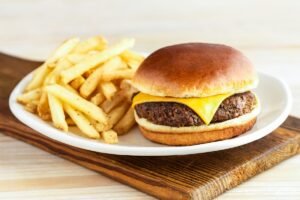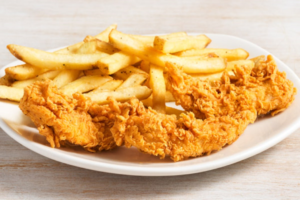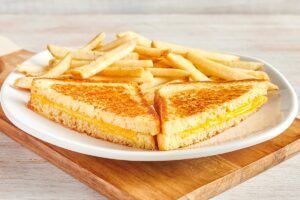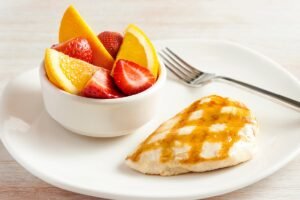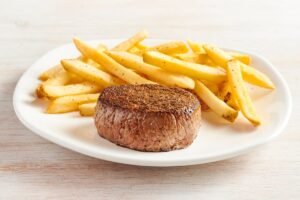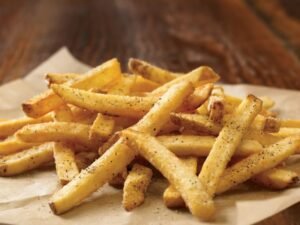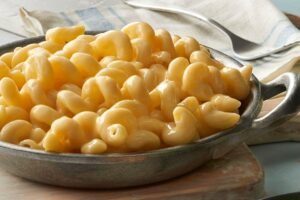Walk into any Outback with kids and watch the magic happen. The moment those Joey menus hit the table – shaped like boomerangs with built-in crayons – you’ve bought yourself at least 10 minutes of peace. But Outback’s kids menu does more than just distract; it delivers real food that parents won’t feel guilty about ordering while keeping portions (and prices) sized for smaller appetites.
This isn’t your typical kids menu loaded with nothing but nuggets and fries. Sure, those options exist because sometimes that’s the hill you’re not willing to die on, but Outback figured out how to sneak in grilled proteins and actual vegetables without triggering meltdowns. The kids menu serves nearly 2 million meals monthly across all locations, making it a serious business disguised as child’s play.
The Psychology Behind the Menu
Outback’s kids menu design follows deliberate psychological principles that most parents never notice but subconsciously appreciate. Menu items use fun Australian-themed names that kids can pronounce and remember. “Mac-A-Roo” sticks in a 5-year-old’s brain better than “macaroni and cheese,” creating ownership over their choice.
The boomerang-shaped menu serves multiple functions. Kids can color on it while waiting, reducing restlessness. The unique shape makes it special, different from boring adult menus. The attached crayons mean no hunting for entertainment when hunger-induced meltdowns loom. After meals, kids often take menus home, creating positive associations with Outback that influence future restaurant decisions.
Portion sizes hit the sweet spot between “too much waste” and “still hungry.” The 4-ounce sirloin sounds small but actually exceeds recommended protein portions for children under 10. Sides portion at 3 ounces, enough to satisfy without overwhelming small stomachs or creating the clean-plate battles parents dread.
Kitchen Modifications for Kids
Every kids meal gets special handling in the kitchen, though most modifications happen automatically without parents needing to ask. Seasoning reduces by 75% on all kids proteins – enough for flavor, not enough to trigger “it’s spicy” complaints about black pepper.
Cooking temperatures skew higher for kids meals. While adults might order medium-rare, kids steaks default to medium-well unless specifically requested otherwise. This isn’t just about preference – it’s food safety for developing immune systems. Chicken gets checked twice with thermometers, ensuring 165°F throughout.
Presentation adjustments seem minor but matter immensely. Foods that might touch get separated. Sauces always come on the side. Hot items cool for an extra minute before plating. Servers know to bring kids meals first, even if it breaks normal service order, because hungry kids equal unhappy tables.
The Sides Situation
Kids meals include choice of one side, with options varying slightly from adult selections:
- Aussie Fries (most popular, 67% of orders)
- Fresh steamed broccoli (8% but rising)
- Cinnamon apples (15%)
- Fresh fruit cup (10%)
- Mashed potatoes
The broccoli inclusion seems optimistic, but Outback discovered something interesting: kids more likely accept vegetables at restaurants than home. The “special restaurant broccoli” carries novelty value. Servers trained to mention vegetables first, using positive language like “awesome broccoli” rather than apologetic tones.
Cinnamon apples walk the line between healthy and dessert, letting parents feel good while kids think they’re getting away with something. Made fresh daily with Granny Smith apples, light cinnamon, and minimal sugar – basically apple pie filling without the pie.
Drink Dynamics
Kids beverages follow predictable patterns that inform inventory:
- Sprite/Sierra Mist: 35%
- Lemonade: 25%
- Apple juice: 20%
- Milk: 10%
- Shirley Temples: 10%
The Shirley Temple phenomenon deserves mention. This mocktail makes kids feel sophisticated, mimicking adult drinks with garnish and fancy glass (plastic for safety). Servers report better behavior from kids drinking Shirley Temples, possibly due to feeling included in adult dining.
Refill policies for kids drinks remain unlimited on sodas and lemonade, limited on juice and milk. This prevents sugar overload while managing costs. Smart parents order water with lemon that kids doctor with sugar packets, creating “homemade lemonade” that keeps them occupied.
Birthday Magic and Special Occasions
Outback’s birthday protocol for kids involves more than just singing. The spotted dog sundae arrives with sparkler candle (real flame, not LED), servers gather for the Australian-accented birthday chant, and the birthday child receives a special boomerang that actually returns when thrown properly.
The birthday registration system means families who celebrate once often return annually. Kids remember where they got the cool boomerang and sung to by servers with funny accents. This emotional connection drives significant repeat business from families.
Special needs accommodations happen quietly but effectively. Autistic children sensitive to singing get silent sparkler presentation. Food allergies trigger kitchen protocols ensuring zero cross-contamination. These unspoken adaptations create inclusive environments without making families feel singled out.
Nutritional Reality Check
Parents increasingly scrutinize kids menu nutrition, forcing Outback to balance health consciousness with kid preferences. The grilled options provide legitimate nutrition – the Joey Sirloin delivers 28 grams protein with only 180 calories before sides. Grilled chicken offers even better macros at 35 grams protein for 165 calories.
The fried options tell different stories. Chicken fingers pack 420 calories with 24 grams fat – not terrible for active kids but concerning for sedentary ones. Mac and cheese hits 380 calories, though portion control keeps it reasonable compared to adult mac at 980 calories.
Vegetable sides underwent subtle improvements. Broccoli gets light butter rather than drowning. Apple slices stay fresh with vitamin C wash rather than sulfites. These changes happened gradually, avoiding sudden shifts that trigger kid suspicions about “different” food.
Pricing Psychology for Parents
Kids meals price between $6.99-$9.99, hitting the sweet spot where parents don’t feel gouged but Outback maintains margins. The pricing includes side and drink, eliminating surprise add-ons that frustrate budget-conscious families.
The value perception improves through quality signals. Real steak, even small portions, justifies premium pricing over fast food. Hand-breaded chicken fingers feel worth more than frozen nuggets. Parents rationalize spending when quality visible.
Free additions enhance value without costing much. Extra crackers, additional fruit cup, or second milk rarely get refused. These minimal-cost extras create goodwill exceeding their expense. Parents remember restaurants that don’t nickel-dime families.
Server Training for Family Tables
Servers undergo specific training for family sections during peak kid hours (5:30-7:30 PM). They learn to read table dynamics quickly – tired kids need fast food delivery, energetic ones benefit from paced service that extends occupation.
The kids-first service model means taking children’s orders immediately, even interrupting adult conversations. This prevents hunger escalation and gives kitchens head starts on simple preparations. Kids meals arriving within 7 minutes keeps peace while adults peruse menus leisurely.
Spill protocols exist because spills happen. Servers never react negatively, immediately bring extra napkins without being asked, and often comp the spilled drink without manager involvement. These responses turn potentially stressful moments into positive experiences parents remember.
Allergy and Dietary Accommodations
Food allergies in kids require extreme vigilance. Outback’s allergy protocol involves manager notification, dedicated prep space, and color-coded plates identifying allergen-free meals. The kitchen takes zero chances with children’s allergies.
Common modifications include:
- Dairy-free: Grilled proteins without butter, fruit instead of mac and cheese
- Gluten-free: Dedicated fryer for fries, grilled options, gluten-free buns available
- Nut allergies: Complete kitchen scan for cross-contamination risks
Vegetarian kids find limited but adequate options. Grilled cheese, mac and cheese, and sides create meals. Some locations offer veggie burgers on request. The kitchen will prepare plain pasta with butter or marinara, though it’s off-menu.
Entertainment and Occupation
Beyond coloring menus, Outback provides subtle entertainment that keeps kids engaged. Servers trained in napkin origami create animals during slow moments. The bread arrives warm with honey butter kids can spread themselves, buying precious minutes of occupation.
Tablets and phones increasingly appear at kids tables, but Outback resists installing tablet stands or offering WiFi passwords prominently. The philosophy encourages family interaction over digital babysitting, though they won’t judge parents deploying emergency YouTube.
Some locations feature balloon artists on weekends, creating elaborate animals and swords. These entertainers work for tips but Outback provides space and promotion. The investment in family-friendly atmosphere pays dividends in repeat business.
Evolution and Trends
Kids menu evolution reflects changing parental expectations and childhood preferences. Recent additions include grilled salmon (testing in coastal markets), quinoa mac and cheese (California only), and grass-fed burger options (select locations).
Portion sizes quietly decreased 10% over five years while prices remained stable, responding to childhood obesity concerns. Plates got redesigned with optical illusions making portions appear larger. These subtle shifts avoid triggering “shrinkflation” complaints while promoting healthier consumption.
Future developments include possible plant-based options as younger generations show environmental consciousness. Interactive elements like “build-your-own” categories test well with kids wanting control. Augmented reality menus that animate when viewed through phones represent next-generation engagement.
The Family Factor
Outback’s kids menu succeeds by respecting both children and parents. Kids get food they’ll actually eat in portions they can finish. Parents get quality they trust at prices that don’t break budgets. Servers get trained to handle family dynamics professionally.
The menu creates gateway experiences for future Outback customers. Today’s Joey Sirloin eater becomes tomorrow’s Porterhouse purchaser. The birthday boomerang recipient brings their own kids decades later. These long-term relationships start with chicken fingers and crayons.
Family dining might not be Outback’s core identity, but the kids menu proves they understand its importance. By executing kids meals with the same attention as adult entrées, they’ve created a program that welcomes families without compromising their steakhouse reputation. Sometimes that’s all parents need – a place where kids can be kids while adults enjoy real food, even if that food comes with crayons and a side of controlled chaos.
